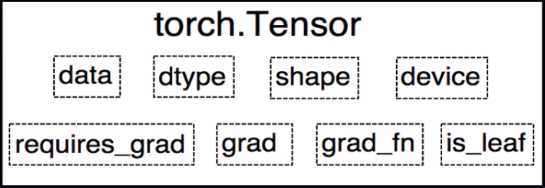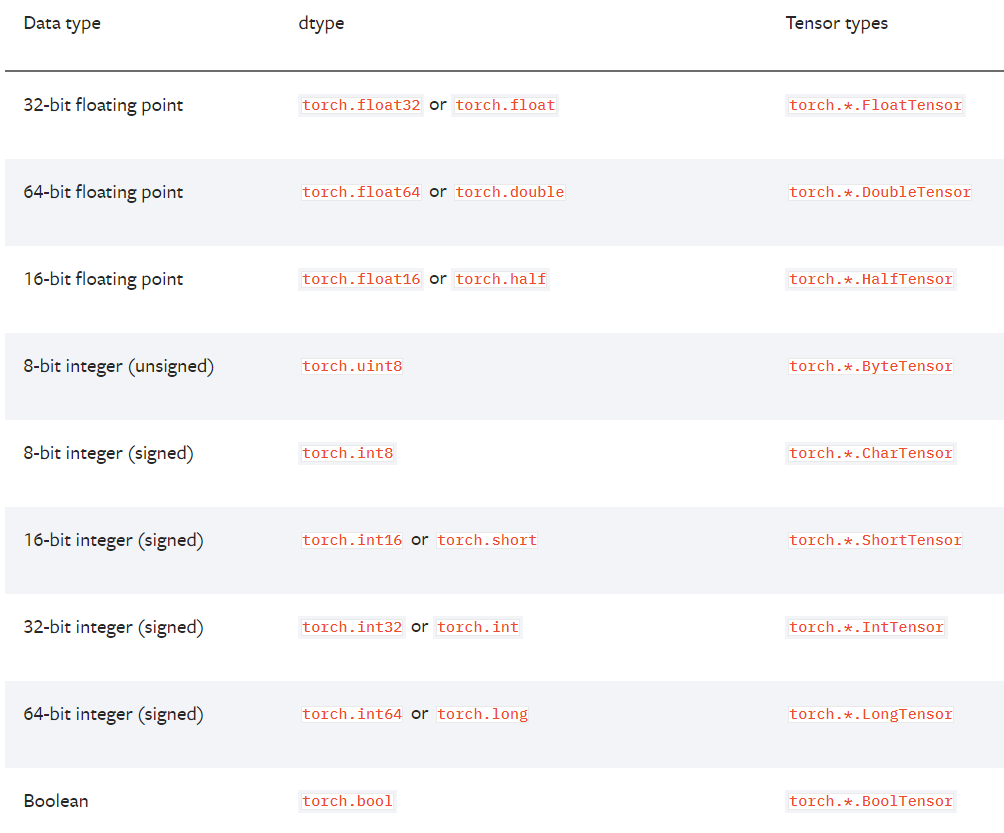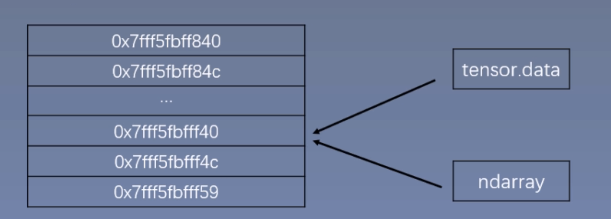Tensor(张量)介绍
Tensor(张量)介绍
1、Tensor 的概念
Tensor 中文为张量。张量的意思是一个多维数组,它是标量、向量、矩阵的高维扩展。
例如:标量可以称为 0 维张量,向量可以称为 1 维张量,矩阵可以称为 2 维张量,RGB 图像可以表示 3 维张量。你也可以把张量看作多维数组。

2、Tensor 与 Variable
在 PyTorch 0.4.0 之前,torch.autograd 包中存在 Variable 这种数据类型,主要是用于封装 Tensor,进行自动求导。Variable 主要包含下面几种属性。
- data: 被包装的 Tensor。
- grad: data 的梯度。
- grad_fn: 创建 Tensor 所使用的 Function,是自动求导的关键,因为根据所记录的函数才能计算出导数。
- requires_grad: 指示是否需要梯度,并不是所有的张量都需要计算梯度。
- is_leaf: 指示是否叶子节点(张量),叶子节点的概念在计算图中会用到,后面详细介绍。

在 PyTorch 0.4.0 之后,Variable 并入了 Tensor。在之后版本的 Tensor 中,除了具有上面 Variable 的 5 个属性,还有另外 3 个属性。
dtype: 张量的数据类型,如 torch.FloatTensor,torch.cuda.FloatTensor。
shape: 张量的形状。如 (64, 3, 224, 224)
device: 张量所在设备 (CPU/GPU),GPU 是加速计算的关键

关于 dtype,PyTorch 提供了 9 种数据类型,共分为 3 大类:float (16-bit, 32-bit, 64-bit)、integer (unsigned-8-bit ,8-bit, 16-bit, 32-bit, 64-bit)、Boolean。模型参数和数据用的最多的类型是 float-32-bit。label 常用的类型是 integer-64-bit。

3、Tensor 创建的方法
利用torch直接创建tensor
torch.tensor()
1 | torch.tensor(data, dtype=None, device=None, requires_grad=False, pin_memory=False) |
- data: 数据,可以是 list,numpy
- dtype: 数据类型,默认与 data 的一致
- device: 所在设备,cuda/cpu
- requires_grad: 是否需要梯度
- pin_memory: 是否存于锁页内存
代码示例:
1 | arr = np.ones((3, 3)) |
输出为:
1 | ndarray的数据类型:float64 |
从 numpy 创建 tensor
torch.from_numpy(ndarray)
利用这个方法创建的 tensor 和原来的 ndarray 共享内存,当修改其中一个数据,另外一个也会被改动。

代码示例:
1 | arr = np.array([[1, 2, 3], [4, 5, 6]]) |
输出为:
1 | 修改tensor |
根据数值创建 tensor
torch.zeros()
1 | torch.zeros(*size, out=None, dtype=None, layout=torch.strided, device=None, requires_grad=False) |
功能:根据 size 创建全 0 张量
- size: 张量的形状
- out: 输出的张量,如果指定了 out,那么
torch.zeros()返回的张量和 out 指向的是同一个地址 - layout: 内存中布局形式,有 strided,sparse_coo 等。当是稀疏矩阵时,设置为 sparse_coo 可以减少内存占用。
- device: 所在设备,cuda/cpu
- requires_grad: 是否需要梯度
代码示例:
1 | out_t = torch.tensor([1]) |
输出是:
1 | tensor([[0, 0, 0], |
torch.zeros_like
1 | torch.zeros_like(input, dtype=None, layout=None, device=None, requires_grad=False, memory_format=torch.preserve_format) |
功能:根据 input 形状创建全 0 张量
- input: 创建与 input 同形状的全 0 张量
- dtype: 数据类型
- layout: 内存中布局形式,有 strided,sparse_coo 等。当是稀疏矩阵时,设置为 sparse_coo 可以减少内存占用。
同理还有全 1 张量的创建方法:torch.ones(),torch.ones_like()。
torch.full(),torch.full_like()
1 | torch.full(size, fill_value, out=None, dtype=None, layout=torch.strided, device=None, requires_grad=False) |
功能:创建自定义数值的张量
- size: 张量的形状,如 (3,3)
- fill_value: 张量中每一个元素的值
代码示例:
1 | t = torch.full((3, 3), 1) |
输出为:
1 | tensor([[1., 1., 1.], |
torch.arange()
1 | torch.arange(start=0, end, step=1, out=None, dtype=None, layout=torch.strided, device=None, requires_grad=False) |
功能:创建等差的 1 维张量。注意区间为[start, end)。
- start: 数列起始值
- end: 数列结束值,开区间,取不到结束值
- step: 数列公差,默认为 1
代码示例:
1 | t = torch.arange(2, 10, 2) |
输出为:
1 | tensor([2, 4, 6, 8]) |
torch.linspace()
1 | torch.linspace(start, end, steps=100, out=None, dtype=None, layout=torch.strided, device=None, requires_grad=False) |
功能:创建均分的 1 维张量。数值区间为 [start, end]
- start: 数列起始值
- end: 数列结束值
- steps: 数列长度 (元素个数)
代码示例:
1 | # t = torch.linspace(2, 10, 5) |
输出为:
1 | tensor([ 2.0000, 3.6000, 5.2000, 6.8000, 8.4000, 10.0000]) |
torch.logspace()
1 | torch.logspace(start, end, steps=100, base=10.0, out=None, dtype=None, layout=torch.strided, device=None, requires_grad=False) |
功能:创建对数均分的 1 维张量。数值区间为 [start, end],底为 base。
- start: 数列起始值
- end: 数列结束值
- steps: 数列长度 (元素个数)
- base: 对数函数的底,默认为 10
代码示例:
1 | # t = torch.linspace(2, 10, 5) |
输出为:
1 | tensor([ 2.0000, 3.6000, 5.2000, 6.8000, 8.4000, 10.0000]) |
torch.eye()
1 | torch.eye(n, m=None, out=None, dtype=None, layout=torch.strided, device=None, requires_grad=False) |
功能:创建单位对角矩阵( 2 维张量),默认为方阵
- n: 矩阵行数。通常只设置 n,为方阵。
- m: 矩阵列数
根据概率创建 Tensor
torch.normal()
1 | torch.normal(mean, std, *, generator=None, out=None) |
功能:生成正态分布 (高斯分布)
- mean: 均值
- std: 标准差
有 4 种模式:
mean 为标量,std 为标量。这时需要设置 size。
代码示例:
1
2
3
4# mean:标量 std: 标量
# 这里需要设置 size
t_normal = torch.normal(0., 1., size=(4,))
print(t_normal)输出为:
1
tensor([0.6614, 0.2669, 0.0617, 0.6213])
mean 为标量,std 为张量
mean 为张量,std 为标量
代码示例:
1
2
3
4
5
6# mean:张量 std: 标量
mean = torch.arange(1, 5, dtype=torch.float)
std = 1
t_normal = torch.normal(mean, std)
print("mean:{}\nstd:{}".format(mean, std))
print(t_normal)输出为:
1
2
3mean:tensor([1., 2., 3., 4.])
std:1
tensor([1.6614, 2.2669, 3.0617, 4.6213])这 4 个数采样分布的均值不同,但是方差都是 1。
mean 为张量,std 为张量
代码示例:
1
2
3
4
5
6# mean:张量 std: 张量
mean = torch.arange(1, 5, dtype=torch.float)
std = torch.arange(1, 5, dtype=torch.float)
t_normal = torch.normal(mean, std)
print("mean:{}\nstd:{}".format(mean, std))
print(t_normal)输出为:
1
2
3mean:tensor([1., 2., 3., 4.])
std:tensor([1., 2., 3., 4.])
tensor([1.6614, 2.5338, 3.1850, 6.4853])其中 1.6614 是从正态分布 $N(1,1)$ 中采样得到的,其他数字以此类推。
torch.randn() 和 torch.randn_like()
1 | torch.randn(*size, out=None, dtype=None, layout=torch.strided, device=None, requires_grad=False) |
功能:生成标准正态分布。
- size: 张量的形状
torch.rand() 和 torch.rand_like()
1 | torch.rand(*size, out=None, dtype=None, layout=torch.strided, device=None, requires_grad=False) |
功能:在区间 [0, 1) 上生成均匀分布。
torch.randint() 和 torch.randint_like()
1 | randint(low=0, high, size, *, generator=None, out=None, |
功能:在区间 [low, high) 上生成整数均匀分布。
- size: 张量的形状
torch.randperm()
1 | torch.randperm(n, out=None, dtype=torch.int64, layout=torch.strided, device=None, requires_grad=False) |
功能:生成从 0 到 n-1 的随机排列。常用于生成索引。
- n: 张量的长度
torch.bernoulli()
1 | torch.bernoulli(input, *, generator=None, out=None) |
功能:以 input 为概率,生成伯努利分布 (0-1 分布,两点分布)
- input: 概率值
原文作者: 贺同学
原文链接: http://clarkhedi.github.io/2021/04/05/tensor-zhang-liang-jie-shao/
版权声明: 转载请注明出处(必须保留原文作者署名原文链接)